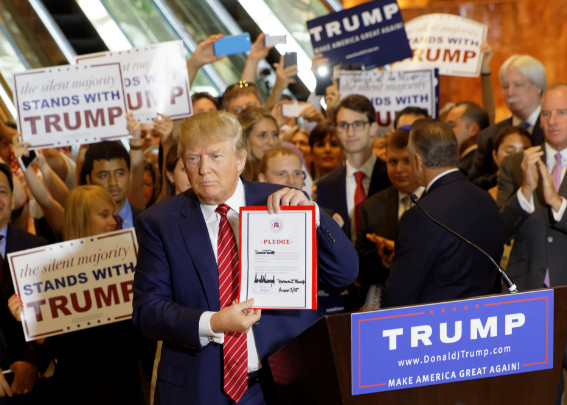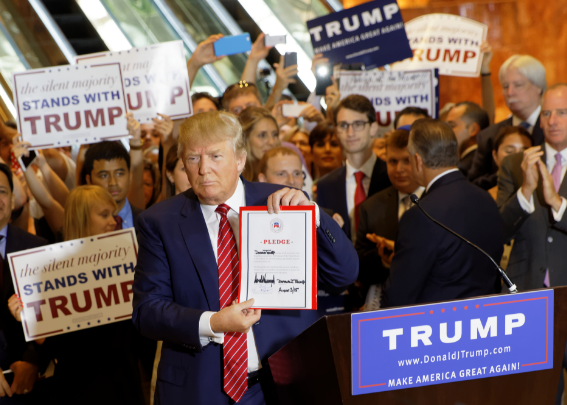
Michael Vadon
Republicans are offering friendly rates for the industry. They are calling for deregulation and are not promising any action on climate change prevention. They are also rejecting the Parisian climate agreement and are promising to cut funding for renewable energy programs. Republicans are also playing down significance of climate change as a national security threat.
At its core, the platform is calling for a greater use of fossil fuels.
The party supports "opening of public lands and the outer continental shelf for exploration and responsible production, even if these resources are not immediately tapped." Republicans have already criticized Democrats for their calls to keep the "wealth in the earth."
They want to cancel federal regulation of distillation technologies, emissions of methane and horizontal drilling, leaving the decision to the states. Finally, the platform calls for full liberalization of trade in energy, which result in increased export of oil and gas.
In short, oil and gas companies are likely to be very satisfied with the President Trump, despite the fact that there is a lot of uncertainty about advisability of this platform. The Democratic platform, in turn, looks much more challenging for the industry.
Democrats are calling for an 80%-reduction in greenhouse gas emissions by 2050. They also support the Department of Justice’s investigation, which accuses the oil companies in misleading the public by hiding real environmental damage from their activity.
They also want an abolish subsidies and tax incentives for fossil fuels extraction, while expanding public support for renewables.
Unlike Republicans, Democrats do not want see an increase in oil and gas production. They are opposed to drilling in the Arctic and on the ocean shelf, and are not going to allow production on public lands.
Democrats’ vision on the energy industry’s future looks the most scaring for the oil and gas producers. They want to achieve proportion of clean energy at the level of 50% within 10 years, and this is only an interim target.
It is not very clear how they will implement this strategy, yet it is an existential threat.
In fact, Hillary Clinton has never been an enemy of oil. However, conditions of the presidential race are creating a new reality. Now, she has to sacrifice something to win the society’s support. When she was Secretary of State, she was trying to help spread the distillation technology to other countries, primarily to China and Eastern Europe.
Continuation of Obama administration’s line will be the most likely outcome in case she becomes President. Obama is not the darling of the oil industry since he created some regulatory obstacles to drilling, and expanded public support for alternatives to oil and gas. Yet, he was not going to destroy the oil shale industry.
During Obama’s presidency, the US have made significant progress in the power sector, increasing share of renewable energy by reducing use of coal and nuclear energy. The transport sector’s effectiveness also showed growth.
In other words, oil companies are inclined to vote for Trump, yet they would still be able to get along with Clinton.
source: oilprice.com
At its core, the platform is calling for a greater use of fossil fuels.
The party supports "opening of public lands and the outer continental shelf for exploration and responsible production, even if these resources are not immediately tapped." Republicans have already criticized Democrats for their calls to keep the "wealth in the earth."
They want to cancel federal regulation of distillation technologies, emissions of methane and horizontal drilling, leaving the decision to the states. Finally, the platform calls for full liberalization of trade in energy, which result in increased export of oil and gas.
In short, oil and gas companies are likely to be very satisfied with the President Trump, despite the fact that there is a lot of uncertainty about advisability of this platform. The Democratic platform, in turn, looks much more challenging for the industry.
Democrats are calling for an 80%-reduction in greenhouse gas emissions by 2050. They also support the Department of Justice’s investigation, which accuses the oil companies in misleading the public by hiding real environmental damage from their activity.
They also want an abolish subsidies and tax incentives for fossil fuels extraction, while expanding public support for renewables.
Unlike Republicans, Democrats do not want see an increase in oil and gas production. They are opposed to drilling in the Arctic and on the ocean shelf, and are not going to allow production on public lands.
Democrats’ vision on the energy industry’s future looks the most scaring for the oil and gas producers. They want to achieve proportion of clean energy at the level of 50% within 10 years, and this is only an interim target.
It is not very clear how they will implement this strategy, yet it is an existential threat.
In fact, Hillary Clinton has never been an enemy of oil. However, conditions of the presidential race are creating a new reality. Now, she has to sacrifice something to win the society’s support. When she was Secretary of State, she was trying to help spread the distillation technology to other countries, primarily to China and Eastern Europe.
Continuation of Obama administration’s line will be the most likely outcome in case she becomes President. Obama is not the darling of the oil industry since he created some regulatory obstacles to drilling, and expanded public support for alternatives to oil and gas. Yet, he was not going to destroy the oil shale industry.
During Obama’s presidency, the US have made significant progress in the power sector, increasing share of renewable energy by reducing use of coal and nuclear energy. The transport sector’s effectiveness also showed growth.
In other words, oil companies are inclined to vote for Trump, yet they would still be able to get along with Clinton.
source: oilprice.com


















